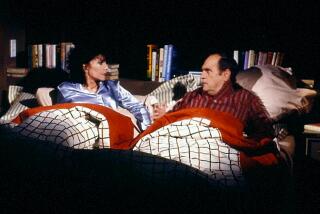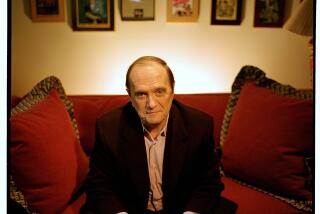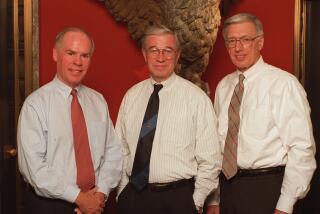Al Neuharth dies at 89; newspaper mogul created USA Today
Al Neuharth, the newspaper mogul who in 1982 made a $1-billion gamble called USA Today that earned derision for its emphasis on brevity, flashy graphics and upbeat stories but endured to become the nationâs largest-circulation newspaper, died Friday in Cocoa Beach, Fla. He was 89.
He died of complications from a recent fall, according to USA Today and the Newseum, the Washington, D.C., news museum he founded.
Described by detractors and admirers as brutish, egomaniacal, brilliant and fiercely competitive, Neuharth was a latter-day Citizen Kane, who in the 1970s turned the small Gannett newspaper chain into the nationâs most profitable newspaper company.
He created several newspapers, but USA Today was his biggest triumph.
âHe launched a newspaper in an era when launching a national newspaper was very rare. People laughed at him and he made a success of it,â Geneva Overholser, director of the USC Annenberg School of Communication and Journalism who butted heads with Neuharth as editor of the Gannett-owned Des Moines Register, said Friday.
âI had some really difficult words with him on more than one occasion. But he had about him a straightforwardness that was impossible not to like,â Overholser said. âIâve never known anyone quite like him.â
USA Today was a different kind of newspaper, designed for a generation of readers raised on television who lacked the time and inclination to read lengthy stories. A bold retort to the gray pages of traditional newspapers, it had color photographs, eye-catching graphics and bite-sizestories with paragraphs set off by bullets. Organized into four distinct sections, it featured a brightly hued full-page weather map and catered to sports fans with a mass of game results and other statistics.
Neuharth, who aimed to capture an increasingly mobile generation of readers desiring an easy-to-digest format when they were at home or on the road, dubbed it âThe Nationâs Newspaper.â
âOur audience will be the whole damned country, but we think we can attract a slice of 4 or 5 percent of the more affluent, better-educated people over most areas of the country,â Neuharth predicted in a 1982 interview with the Miami Herald. âWe wonât compete locally. We will be a second buy.â
Critics, however, derided the paper as gimmicky and âjunk food journalism.â âMcPaperâ became a favorite put-down by traditional journalists appalled by its emphasis on brief, breezy stories. Newsweek poked fun at its founder as âthe man who shortened the attention spans of millions of Americans.â
It lost money for the first five years. But by its fifth anniversary in 1987, revenues had begun to rise and critics began to change their tune, with stories in other newspapers describing USA Today as innovative, even revolutionary.
By the early 1990s, major dailies, including the Los Angeles Times and the New York Times, were redesigning their pages to be more reader-friendly, adding color, snappy graphics and stories that read more quickly.
âAcross the board, people reacted to it,â said Shelby Coffey III, who became editor of the Los Angeles Times in 1989 and is now vice chairman of the Newseum. âSome said they didnât want to go that way. Some took ideas and maybe didnât say much about where they got the ideas. But it certainly had an effect and became part of the landscape of America. It was quite an achievement.â
Neuharth put it this way: âThe editors who called us McPaper stole our McNuggets.â
Known for an often bruising management style, he became a force in the industry for fuller coverage of minorities and greater diversity in newsroom staffs.
âAl was many things â a journalist, a leader, a serial entrepreneur, and a pioneer in advancing opportunities for women and minorities. But above all,â Gannett Chief Executive Gracia Martore told USA Today, âhe was an innovator with a unique sense of the public taste.â
Neuharth was born in Eureka, S.D., on March 22, 1924. His farmer father died when he was 2, forcing his mother to take jobs as a waitress, laundress and seamstress. By age 11, Neuharth was holding down jobs, delivering newspapers and later working in the composing room of a small newspaper in Alpena, S.D.
After high school, where he was editor of the campus paper, he attended Northern State Teachers College on a scholarship, intending to study law. But at 18 he joined the Army and served in the infantry in Germany during World War II.
Discharged in 1946, he returned to South Dakota and changed his career plans. He studied journalism at the University of South Dakota, graduating cum laude in 1950.
His first job was reporting for the Associated Press in its Sioux Falls bureau. After two years, he quit to launch a sports weekly, but it flopped. In 1954 he joined the Miami Herald as a reporter, earning $95 a week. By 1960 he was assistant executive editor of the Detroit Free Press, which, like the Miami Herald, was owned by the Knight newspaper chain.
In 1963 he joined Gannett, which then had 16 newspapers in five states. He later said that one of the primary attractions of Gannett was that it was not family-run like Knight, which meant an easier ride to the top for an ambitious outsider.
He became president of Gannett in 1970 and chief executive in 1973. By the time he launched USA Today he had built Gannett into a major force with about 80 daily newspapers from Vermont to Guam and a larger circulation than the New York Times, the Washington Post, the Los Angeles Times and the Chicago Tribune combined.
His biggest blunder during his 16 years as Gannett chief was a failed merger with CBS in 1985. He freely admitted that his arrogant demands spoiled the negotiations. âMy ego outran my brain,â he told the Boston Globe in 1989, when his autobiography was published.
He titled that book âConfessions of an S.O.B.,â and he included chapters written by two of his ex-wives, one of whom described him as âa snake. Heâs sneaky and slithers around and sheds his old skin as he grows,â Lori Wilson wrote.
Neuharthâs first marriage, to Loretta Helgeland, ended in divorce in 1972. His marriage to Wilson ended in 1982.
He married Rachel Fornes in 1993 and adopted six children with her. They survive him, along with two children from his first marriage and two grandchildren.
More to Read
Start your day right
Sign up for Essential California for the L.A. Times biggest news, features and recommendations in your inbox six days a week.
You may occasionally receive promotional content from the Los Angeles Times.







